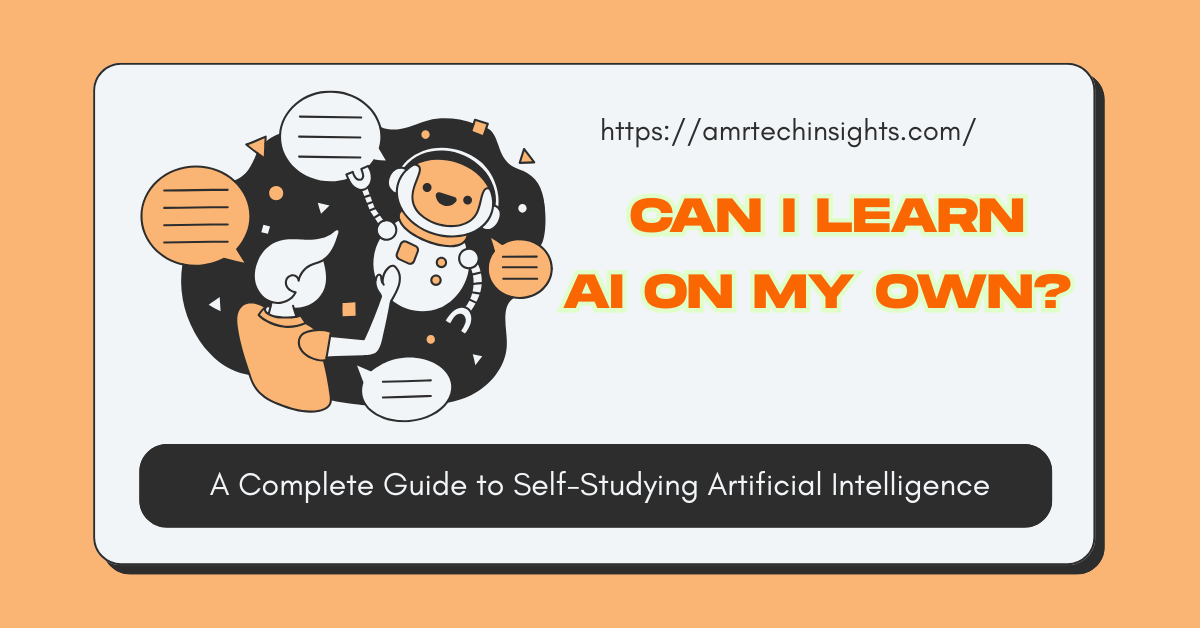A lot of people ask me, “Can I learn AI on my own?”I decided to investigate this question for myself and share my honest findings. This essay shares my journey to learn AI on my own. The process of studying AI on my own has been enlightening, difficult, and surprisingly rewarding. Whether your goal is to switch occupations or simply to expand your knowledge, familiarity with AI fundamentals is essential.
When I learned AI on my own, I saw how powerful it can be to transform things. AI alters how we work, talk to each other, and solve problems by taking care of tasks and making smart apps work. Learning AI not only helps you get a better job, but it also helps you think more clearly and solve problems better.
What are the benefits of learning AI?
AI isn’t simply a word that people use; it’s going to change the future in a huge way. I rapidly learned that learning about AI on my own not only helps me acquire a job, but it also helps me grasp how technology changes the world. Over the next 10 years, experts say that the average annual income for AI engineers will go up by 23%.
I was driven by both my job prospects and my curiosity. I wanted to learn more about how AI works in the actual world, including how it can guess what would happen and how it can interpret spoken language. I could learn AI at my own speed and in areas that interested me because I chose to do it myself.
Setting up the way you learn
When you are keen to learn AI on your own, you need to have a plan. I made a plan to mix theory, coding practice, and real-world tasks. The four steps I took were
Look at the skills you have right now: I reflected on my current understanding of math, statistics, and programming to figure out what I needed to learn next to successfully learn AI on my own.
- Set Goals: I wanted to improve my talents and build a portfolio of my work.
- Choose how you are keen to learn: I took online classes, read books, and watched tutorials.
- Set a timeline: I stayed on track by breaking the plan down into monthly targets that I could handle.
This structure helped me see things clearly and find my way. It’s difficult to learn AI on my own, but having a clear plan makes it possible.
Improving Required Skills While Learning AI on My Own
It’s too much to jump right into AI without becoming ready beforehand. I started with the prerequisites:
- Calculus, probability, and linear algebra are the main parts of AI algorithms.
- Statistics: You need to know about things like regression, distribution, and likelihood.
- My main programming language was Python, but R or Java can also work.
Curiosity and the ability to adapt are just as important as technical competence. Since AI changes quickly, I got used to being flexible and trying new things while learning AI on my own. I also learned to accept my mistakes, because they often teach me the most.
Step-by-Step Guide to Core AI Skills for Those Learning AI on My Own
After I learned the foundations, I went on to the most important AI skills:
- I practiced Python every day by working with arrays, lists, trees, and dictionaries. Doing small coding activities helped me think more clearly.

I learned AI on my own by practicing Python in Google Colab. I could write code, test little models, and fix bugs in a hands-on fashion. You can learn the foundations of Python for AI.
- Data Science: I learned how to use tools like Pandas and Matplotlib to clean, see, and analyze data. Projects that you could touch and feel make ideas real.

Using Matplotlib to make graphs of data helped me understand AI ideas much better. I could see patterns, figure out distributions, and check models with my eyes. Consider exploring data science for those who are new to the field.
- I learned about supervised and unsupervised learning in machine learning. Supervised learning helped me predict outcomes with labeled datasets, whereas unsupervised learning showed me patterns in data without labels, all while I was learning AI on my own.
- Deep Learning: I used TensorFlow to play around with neural networks. It was challenging but gratifying to develop a simple picture recognition model.

Working with a TensorFlow neural network helped me learn about deep learning in a hands-on way. I could examine how layers work together, train models, and make things work better step by step. Learn the basics of neural networks.
It takes time to learn AI on my own. It took me hours to fix models, but each time I did, I learned more about them.
Looking at AI Tools and Libraries
Using the correct tools sped up my progress. Knowing how to use libraries like NumPy, Scikit-learn, and TensorFlow made it possible to work on real AI projects. I followed a nine-month intensive plan:
- Math, statistics, programming, and data structures in the first three months
- Data science, machine learning, and deep learning for months 4–6
- Months 7–9: AI tools, projects that help you specialize, and getting ready for a career
Pre-built libraries let me focus on using ideas instead of having to construct everything from scratch. One surprising thing I learned was that pre-trained models might swiftly adapt to new jobs with little fine-tuning. I learned that you can study alone without much computing power; you just need to use your tools well.
Essential AI Tools for Learning on Your Own
| Category | Tools / Libraries | Purpose / Use |
| Programming & Computational Tools | Python, R, Java | The most important languages for AI development |
| Jupyter Notebook | Ideas for coding and testing that are interactive | |
| Data Processing & Analysis Tools | NumPy | Calculating numbers and working with matrices |
| Pandas | Organize, clean, and change datasets | |
| Matplotlib & Seaborn | Visualize data patterns | |
| Machine Learning Libraries | Scikit-learn | Supervised & unsupervised algorithms |
| XGBoost & LightGBM | Efficient predictive modeling | |
| Deep Learning Frameworks | TensorFlow, PyTorch | Create and teach neural networks. |
| Keras | A simpler interface for deep learning models | |
| Pre-trained Models & AI APIs | Hugging Face Transformers, GPT API, Google Cloud AI | Use and improve models that already exist for NLP and vision tasks. |
| Project Management & Collaboration Tools | Git & GitHub | Version control and code collaboration |
| Google Colab | Free cloud-based AI experiments without heavy computing |
Getting to Know the AI Hierarchy
I learned that understanding the AI hierarchy helped me grasp many concepts while learning AI on my own.
- Artificial Intelligence (AI): The field that includes all smart systems.
- Machine Learning (ML) is a part of AI that looks at data to make predictions.
- Deep Learning: A type of ML that uses neural networks that are based on how the brain functions.
- Large language models (LLMs) are deep learning models that have undergone training on vast amounts of text data.
- Generative AI uses LLMs to make new things, such as text, pictures, or sounds.
This hierarchy helps me pick the correct models and tools for different jobs. For instance, LLMs are great at linguistic problems, whereas convolutional neural networks are great at processing images.
Problems Along the Way While You Learn AI on My Own
There were problems with learning AI on my own:
- Overwhelm: At first, the amount of information seemed too much to handle.
- Debugging Models: Neural networks didn’t always come together; therefore, they had to be tested again and again.
- Choosing Resources: It required some trial and error to find good courses and tutorials.
I overcame these challenges by following my plan, seeking help from forums, and breaking tasks into small, manageable pieces while I worked to learn AI on my own. Consistent studying proved far more effective than occasional intense effort.
Important Results and Surprises
The results were evident after months of effort to learn AI on my own:
- I could develop AI models and improve them on my own.
- Doing things with your hands made ideas stick far better than just reading about them.
- AI had a real effect on me; I could automate tasks, see patterns, and try new things.
- I was astonished to discover how accessible AI tools are. You don’t need much money to learn AI on your own—you can become proficient using free or low-cost resources and structured guidance
Things I’ve Learned and Suggestions for Those Learning AI on My Own
- Short, daily study sessions were better than long, irregular ones because they were more consistent.
- Engaging in hands-on projects is crucial as it ensures the retention of ideas.
- Community Support Helps: Study groups and online forums help you learn faster.
- Focus on the Basics: If you have a basic grasp of algebra, statistics, and programming, you can handle more advanced topics while you learn AI on your own
- Accept mistakes: Debugging problems teaches things that theory can’t.
- Learning AI on my own changed the way I solve problems by making me more curious, willing to try new things, and willing to keep trying.
Invitation and Reflection
You can definitely learn AI on your own. Self-study works really well when you have a plan, stick to it, and use effective resources. The trip is challenging, but it’s worth it since you learn by doing.
I suggest you start small by creating basic projects, joining AI groups, and experimenting regularly while you learn AI on your own. See problems as opportunities to grow, share what you’ve learned, ask questions, and connect with others who are also learning AI
When you learn AI on your own, you do more than just develop models. You also change the way you think, get better at solving problems, and learn how technology changes the world.
Disclaimer: These screenshots are just meant to be used for teaching and showing. They show ideas and steps I took while I learned AI on my own. They are not full production projects.
Last updated on August 22, 2025

Hi, I’m Amarender Akupathni — founder of Amrtech Insights and a tech enthusiast passionate about AI and innovation. With 10+ years in science and R&D, I simplify complex technologies to help others stay ahead in the digital era.



